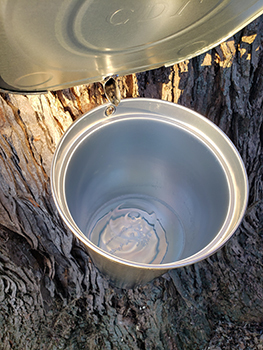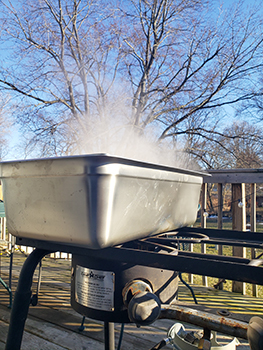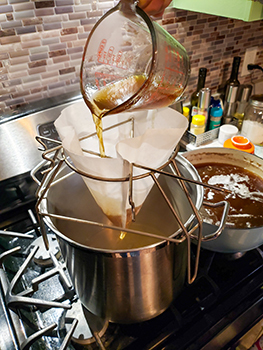What it boils down to
Join us for a foray into urban syrup making
By RACHEL COALE
Communications representative, Forest Resources Division
Michigan Department of Natural Resources
Sunshine gleaming off metal buckets in Michigan’s maple forests heralds the end of winter’s viselike grip on the landscape. This telltale sign of spring is part of a story I grew up romanticizing – the process of collecting sugar maple sap and turning it into syrup.
Learning to make maple syrup seemed like a natural evolution for me as a foraging enthusiast.

The problem?
I live on a half-acre lot on the edge of town without a sugar bush, the term for a stand of sugar maples, which I thought was needed to explore this heritage tradition.
Reading up on the subject, I realized I didn’t have to have a whole sugar bush, or even a sugar maple, to get started.
I decided to explore syruping on the micro level, with a single tree. Not even a sugar maple, but its shaggy-barked cousin with deeply notched leaves, a towering silver maple.
This tree provides much-needed backyard shade in summer. But would it yield usable sap? Although they don’t boast the prized 2% sugar content of a sugar maple, silver maples still clock in with an average of 1.5% sugar, which seemed like it could be worth an attempt.
Galvanized with enthusiasm after reading a few syruping blog posts, I ordered a three-bucket starter kit, which arrived on my doorstep in a snowstorm. I hoped to get a few gallons of sap over the season as the warming weather coaxed energy from my tree’s roots back into the trunk and branches.
Collecting sap: Prepare for a deluge
My massive tree splits into three trunks, each much larger than the 10-inch minimum needed to tap. I agonized over where to put the taps, picked three locations at about hip height and finally got out the power drill.
After drilling holes upward into the tree and gently whacking spouts, called “spiles,” into the tree trunk with a rubber mallet, the taps immediately started dripping. They made a satisfying plink - plink - plink as drops hit the bottom of the metal buckets.
|

I couldn’t resist trying the sap straight from the tree. It was cold, with the texture of water and a taste like the first whispers of spring: very slightly sweet, with an enigmatic, botanical flavor reminiscent of fresh-cut wood.
After the first 12 hours, a little over a gallon of sap had collected in the buckets. And then the wild temperature swings began.
The slow plink-plink in my buckets became a faster plink-plink-plink-plink-plink as a sunlit, 45-degree day drew sap up the tree, and down again with a freezing 25-degree night.
At first, I was delighted. So much abundance! But then the buckets began to fill faster than I could empty them.
My storage capacity – a hopeful array of mismatched 5-gallon buckets and a few old milk jugs – quickly became overwhelmed. Even an ice storm followed by a snowstorm didn’t slow the tree down for long.
Worried, I sent my husband to the store for more buckets. And again, as those quickly filled. My “micro” operation suddenly felt very macro indeed. I needed to start boiling down my sap.
In the end, I was satisfied with my haul. I pulled the taps to focus on processing the more than 45 gallons of sap in my basement before it spoiled. Fresh sap, if kept cool, should last about a week.
The boiling: An eternity of steam
The biggest challenge in a syruping operation is evaporation. Reducing 40 gallons of sap yields about one gallon of syrup in a sugar maple, and somewhat less with other maple varieties.
|

I filtered the sap through a sieve to remove bits of bark or bugs that might have gotten in, set up a borrowed Camp Chef burner on my deck and got to boiling … and boiling … and boiling.
Why not boil off sap indoors on the stove where it’s cozy and warm? Boiling adds gallons of steam to the air, a dangerous plan if you want to do it inside your home.
I didn’t have to imagine the consequences – a coworker warned me with the story of her father’s intrepid effort during her childhood, which ended with the collapse of a plaster kitchen ceiling!
As I boiled and topped off our makeshift evaporating pan (a repurposed restaurant chafing dish) with more sap, I realized that each addition of cold sap killed the boil and slowed down the whole operation.
I began to use a slow cooker to warm the sap, and I was able to process many more gallons during each boiling session.
Finishing: The tricky part
After hours and hours of boiling off sap, I had several quart jars of tantalizingly almost-there syrup in the refrigerator. Although the main boil should be done outdoors, the finishing steps should be completed where you can keep an eye on the precious syrup to ensure it doesn’t burn.
The final test is to get the syrup to boil 7 degrees hotter than water, then filter out any minerals or sugar sands formed during the process. These bits look like brownish muck and cloud the syrup with grit.
At this stage, my husband and I peered over the boiling pot like anxious mother hens on a nest, debating whether we’d done it correctly. We checked the pot frequently with a thermometer, waiting for it to reach the magic temperature of 219 degrees Fahrenheit.
|

After what seemed like an eternity, the thermometer finally flickered, then held, at 219 degrees. Working quickly, we followed instructions from Michigan State University Extension to preserve the precious syrup in glass canning jars, where the finished product sparkled like a tawny jewel.
Surrounded by sticky pots and spatulas, we grinned at our accomplishment. Our wild idea had paid off.
Here’s the answer to the question everyone asks: We ended up with just over a gallon of syrup once the project wrapped up. The syrup is delicious: light amber and delicate, richly sweet, with woodsy caramel notes.
Would I do it again? Absolutely
Knowing how much work it is, I’ll never complain about the price of maple syrup again. The real deal is an effort, but the process was fun and rewarding.
Now that I’ve made the initial investment in supplies, I can see diving into this project every year to welcome the lengthening days of early spring.
If there’s a year when I don’t want to tap maples, Michigan thankfully produces a lot of syrup – the fifth most in the nation. In 2022’s record-breaking season, commercial syrupers in Michigan reported 190,000 gallons, following behind Wisconsin, Maine, New York and Vermont, which took the top spot with a whopping 2.5 million gallons of the sweet stuff.
Interested in your edible outdoors? Find information on making maple syrup, foraging for wild berries and searching for elusive morel mushrooms at Michigan.gov/Foraging. You can also get a firsthand look at syruping at Hartwick Pines State Park during its annual Maple Syrup Day, April 8.
|
Check out previous Showcasing the DNR stories in our archive at Michigan.gov/DNRStories. To subscribe to upcoming Showcasing articles, sign up for free email delivery at Michigan.gov/DNREmail.
Note to editors: Contact: John Pepin, Showcasing the DNR series editor, 906-226-1352. Accompanying photos and a text-only version of this story are available below for download. Caption information follows. Credit Michigan Department of Natural Resources, unless otherwise noted.
Text-only version of this story.
Boiling off: A sap boiler is shown operating on an outdoor deck.
Boiling off - 2: A sap boiler is shown working on an outdoor deck, with steam rising into the air.
Filtering: Sap is sifted through a filter to remove impurities.
Finished syrup - 1: A hand-held Mason jar filled with syrup is shown.
Finished syrup - 2: Mason jars filled with syrup are shown on a countertop.
Sap collection: A open metal bucket shows sap being collected from a silver maple tree.
Tapping - 1: A metal bucket is shown on a silver maple tree to collect sap for making maple syrup.
Tapping - 2: Metal buckets are shown attached to a silver maple tree in the author's backyard.
|